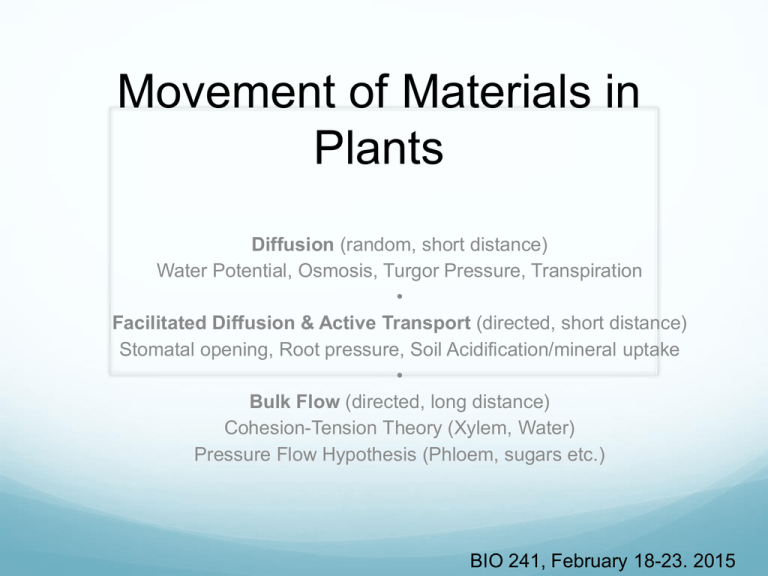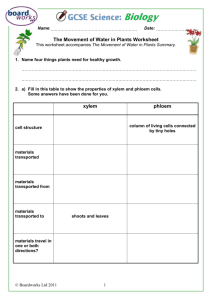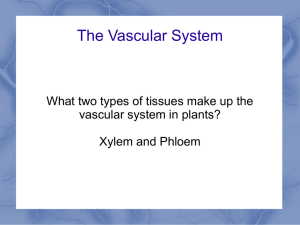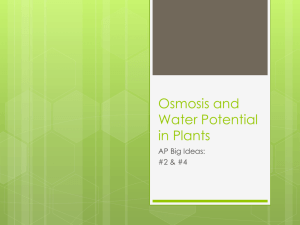Movement of Materials in Plants
advertisement

Movement of Materials in Plants Diffusion (random, short distance) Water Potential, Osmosis, Turgor Pressure, Transpiration • Facilitated Diffusion & Active Transport (directed, short distance) Stomatal opening, Root pressure, Soil Acidification/mineral uptake • Bulk Flow (directed, long distance) Cohesion-Tension Theory (Xylem, Water) Pressure Flow Hypothesis (Phloem, sugars etc.) BIO 241, February 18-23. 2015 Review of Plants and Water Why do plants need water? What’s special about the structure of water? Movement of water through cell walls and membranes The concept of “water potential” (the energy of water” Why plants need water: Solvent for enzymes and their substrates Medium in which biochemical reactions take place Water is required for stomatal opening Water provides turgor pressure In some plants, water is used for reproduction Yes, e--donor for oxygenic photosynthesis Special Properties of Water Inter-molecule H-bonding Cohesion Surface Tension High latent heat (energy that must be released or absorbed during phase change) Liquid at the temperatures that prevail over most of the Earth. Evaporative cooling- many H bonds must be broken for evaporation. This requires energy (heat). That heat is then carried away by the “sped-up” evaporating water molecules. (–) (+) Can dissolve many things! H2O molecules form “shells” around charged solute atoms or polar parts of molecules, carrying them into solution. Universal Solvent? Due to their polarity, water molecules form “shells” around charged particles or polar portions of molecules, “carrying” them into solution. -completely non-polar substances don’t dissolve well. Surface Tension and Cohesion Thanks to the strong affinity of water molecules for each other: Water will “flow” down an energy gradient. Waterfall: high gravimetric potential to lower gravimetric potential Osmosis: special case of diffusion; water diffuses across membrane from high water potential to low water potential. Membrane is required (othwerwise the solutes would move). For purposes of figuring out which way water will move across a membrane, Water Potential can be thought of as analagous to “water concentration.” +ΨG ΨG = gravitimetric potential (= weight) Maximum = 0 (pure water) Most of the contributing factors REDUCE the energy of water --- reduce its potential to “do work” -- reduce its ability to diffuse -- Ψp may be positive (pressurized/turgid cells) or negative (in plasmolysed cells and xylem) Values given are measured relative to pure water. “How much tension would the solution in question put on pure water?” (1 atmosphere = 0.1 megapascal = 1 bar) Measured with a tensiometer. • Membranes often have aquaporins (protein channels for water movement). • Osmosis= diffusion of water through membrane, down energy gradient Pure water Cell, soil, air… Change in pressure can be used as an indicator of the direction/magnitude of water movement. Pressure equalizes water potential In a turgid cell. Measuring Water Column Tension in Xylem “Pressure Bomb” 1. Cleanly sever a small branch with leaves. • The water column in the xylem, under tension, ‘snaps’ and is withdrawn to some interior point in the stem. Replaced with air. 2. Seal gasket around cut stem, insert branch into pressure chamber. 3. Pressurize chamber with inert gas. When water appears at the cut surface, the pressure in the chamber is equal in magnitude to the tension on the water column when cut. Common method used by ecologists studying xylem tension (water potential gradient) typically experienced/tolerated by plants in different environments. Osmosis Possible routes: Apoplast and Symplast (or a combination of the two) Apoplast – cell walls and intercellular spaces. -- unless specifically modified, cell walls are very permeable to water and dissolved X. -- passive process; osmosis/diffusion. passive = occurs without additional energy input. -- water moves from high water potential low -- Dissolved X molecules tend to move from high X concentration low Symplast – interconnected cytoplasm of cells. -- to move through the symplast, water and solutes must enter the cytoplasm by passing through a plasma membrane. ** the plasma membrane is differentially and selectively permeable ** Turgor Pressure Support for plant leaves. High concentration of salts and other solutes in cytoplasm (vacuole) cells tend to absorb water by osmosis. Hydrostatic pressure builds up inside plant cell. Outward-pushing turgor pressure is equal to innerdirected wall pressure. (equal and opposite forces) Gives a degree of rigidity to leaves and non-woody stems. Some plants have leaves with more sclerenchymatous tissues for additional toughness. (slerophyllous vegetation) Loss of turgor pressure: occurs when gradient of water potential reverses (higher inside cell, lower outside cell) water leaves the cell reduction in turgor pressure shrinkage of protoplast and wilting Turgor Pressure & Plasmolysis When cells are hypertonic (greater solute conc. than surroundings) ψcell < surrounding soln. So water diffuses into cell (osmosis) builds positive pressure, increasing ψcell When cells hypotonic (lesser solute conc.), or if ψsurrounding is for some reason very very negative, reversing ψ gradient, cells undergo plasmolysis. Plasmolysis Under normal “well hydrated” conditions, which has the higher water potential? The cytoplasm, or the water in the cell wall? Plant Water Relations • CO2 is necessary for photosynthesis • When stomata are open, so that CO2 can enter the leaf, H2O exits (diffusion of water vapor). This is Transpiration. • For cells to maintain turgor pressure, transpiration must be balanced by water uptake. ` Concept of Water Potential • Pressure potential A Water Potential Gradient exists between soil and atmosphere. Atmosphere ~ –500 bars (1 bar = 1 atm) Soil ~ -0.3 – -15 bars –500 bars Plants (land plants, anyway) straddle the interface between Atmosphere and soil. Ψ gradient provides the energy for bulk flow movement of water from roots to leaves, to replace water lost through transpiration. –15 bars to –30 bars –3 bars to –20 bars –0.3 bars to –15 bars As soil water content decreases, remaining water is tightly held by soil particles (matric potential). Surface tension increases. Overall water potential goes down (more negative). To maintain water flow, plants must maintain lower water potential in roots (solute potential? Other force??) In Roots: water diffuses from soil into the root as long as Ψsoil > Ψroot . Water flows down the energy gradient… What about mineral nutrients? Can’t just flow into plants in solution (blocked by membrane, plus concentration gradient opposes diffusion into roots, PLUS + ions are strongly bound to soil particles) Modes of Transmembrane Transport Simple diffusion Facilitated diffusion Active Transport - Solute moves down its - down conc. Grad. -against conc. or concentration gradient -carriers or channels electrochem grad. - Water moves down Water - Aquaporins (water and - pump (ATP-ase) potential gradient (osmosis) neutral mols). - ions (K+, Na+, Cl-, Ca2+) Soil acidification: energy used to pump H+ ions out of root hairs, into soil, against electrochemical gradient. H+ displace other anions from negatively-charged soil particles. Anions can then be transported into root cells by active transport, facilitated diffusion, etc. Cells of endodermis actively transport ions into the vascular tissue. Water follows the water potential gradient… From the root hairs, water follows one of two main paths to the xylem: (a) Apoplastic pathway or (b) Symplastic pathway (or a combination of the two (transcellular). Root pressure is the result of an active process: “secretion” of ions into the vascular tissue of the root. - Root pressure disappears if plants kept in dark for long period, or poisoned. Why “secretion?” During transpiration, water absorption by roots is a passive process, driven by transpiration. Transpiration negative pressure in tracheary elements in leaves tension on water column Root pressure ranges from 0.3-0.5 megapascal (1 atmosphere = 0.1 megapascal = 1 bar) Absorption of water and ions by roots. • Facilitated by root hairs. (extension of root epidermal cells) Root pressure and Guttation Not condensation (dew), but Guttation droplets. Guttation = water loss due to root pressure. Water is forced out of leaves through special openings (hydathodes) located along the leaf margin. Hydathode structure Radial micellation: radial orientation of cellulose microfibrils. – guard cells can increase in length, not width. Phototropins: blue light sensing pigments Demonstration of Cohesion-Tension theory Cells of the Xylem Conducting cells (Tracheary elements; sclerenchyma) Imperforate: tracheids (found in most vascular plants) Perforate: vessel elements (found in Angiosperms) Fibers (sclerenchyma, mechanical/structural support) Xylem parenchyma (storage of water/nutrients) Plant cell walls have evolved features that protect the water column from distruption by cavitation or injury. 2° wall Perforation plates at ends of vessel elements prevent embolism from expanding. Surface tension prevents water movement through the small holes in the pit membrane (1° wall) Pit Membrane in conifer tracheids bordered pit pairs. Hydraulic Lifting Ion uptake is an active process (requires energy and cellular activity) Inorganic nutrients are exchanged between xylem and phloem. A= absorbtion U=unloading I=interchange Water and assimilate pathways through a leaf. Assimilate transport Translocation: movement of substances through phloem. Direction: from sources to sinks. Sources: exporters of assimilate solutes (aka “photosynthate,” sugars) Photsynthesizing leaves, storage tissues. Sinks: importers/consumers of assimilate. Actively growing meristematic regions, root tissues, developing fruits, or any plant part unable to meet nutritional needs (remember respiration occurs in all living cells) Patterns of assimilate transport: Cells in Phloem Sieve Tube Elements (members) with protein-contianing plastids (corn, a) and P-protein (squash, b) Sieve tube elements and companion cells Note sieve plates and P-protein bodies in STEs Sieve tube element and companion cell development. Derived from same mother cell. Sieve plate = cell wall with large plasmodesmata (pores). Most contents of STE’s autodigested, but cell still living (maintained by CC) Phloem cell morphology Sieve tubes in transverse and long. section. (microradiographs, film exposed to tissues of plant that had assimilated 14CO2) Aphids are useful! - provide what technology can not: Aphid stylet mouthpart penetrates phloem sieve tube without disrupting translocation process. Normally if sieve tube is ruptured, pressure fluctuation dislodges P-proteins along STM wall, which plug the sieve plate (end wall). Aphids can be anesthetized and severed from their stylet ()…by analyzing phloem sap obtained through the stylet, we know: Assimilate contents: 10-25 % “dry matter” • sucrose (90% of dry wt.) • amino acids • proteins • RNA • hormones • inorganic ions (Mg++, PO43-, K+, Cl- ) Translocation rate ~ 100 cm/hour Pressure Flow Hypothesis Osmitically-generated turgor pressure gradient in sieve tubes. - Phloem loading at source: Assimilate sucrose actively transported into sieve tube member (STM). - lower water potential - water moves into STM from xylem - increased turgor pressure in STM - bulk flow through sieve tube in direction of lower pressure (toward sink) - @ sink, active transport unloading of - Assimilate from STM, increases water potential of STM relative to surrounding cells. Water moves out…lower turgor pressure in STM at sink. Sugar beet (Beta vulgaris): apoplastic loading Fuchsia triphylla: Symplastic Loading



